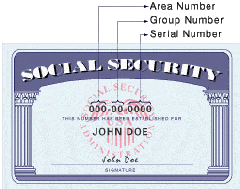Social security numbers (SSNs) are not random numbers. They are assigned regionally and in batches. The nine-digit SSN, which has been issued in more than 400 million different sequences, is divided into three parts:
- Area numbers – The first three numbers originally represented the state in which a person first applied for a social security card. Numbers started in the northeast and moved westward. This meant that people on the east coast had the lowest numbers and those on the west coast had the highest. Since 1972, the Social Security Administration (SSA) has assigned numbers and issued cards based on the ZIP code in the mailing address provided on the original application form. Since the applicant’s mailing address doesn’t have to be the same as his residence, his area number doesn’t necessarily represent the state in which he resides. For many of us who received our SSNs as infants, the area number indicates the state we were born in. You can find out which area numbers go with each state here.
- Group numbers – These two middle digits, which range from 01 through 99, are simply used to break all the SSNs with the same area number into smaller blocks to make administration easier. (The SSA says that, for administrative reasons, group numbers issued first consist of the odd numbers from 01 through 09, and then even numbers from 10 through 98, within each area number assigned to a state. After all the numbers in group 98 of a specific area have been issued, the even groups 02 through 08 are used, followed by odd groups 11 through 99.)
- Serial numbers – Within each group designation, serial numbers — the last four digits in an SSN — run consecutively from 0001 through 9999.
According to the SSA, the numbers are not recycled. Upon an individual’s death, the number is removed from the active files and is not reused. Recycling numbers might become an issue someday, but not any time soon — statisticians say that the nine-digit SSN allows for approximately one billion possible combinations!
My Social Security Number – How Secure Is It?
History of SSN usage. When Social Security numbers were first issued in 1936, the federal government assured the public that use of their use would be limited to Social Security programs such as calculating retirement benefits.
Today, however, the Social Security number (SSN) has become the de facto national identifier. It is also often used as an authenticator to confirm the identity of individuals. The use of SSNs as both an identifier and an authenticator makes these numbers highly desirable to criminals, such as identity thieves. For more information on this problem, read “Why SSNs Are Not Appropriate for Authentication” at www.privacyrights.org/ar/FTC-SSNworkshop-Speech.htm
Government agencies and private businesses continue to use SSNs for a wide range of non-Social Security purposes — such as employee files, medical records, health insurance accounts, credit and banking accounts, university ID cards, utility accounts, and many more. Read the rest of the article here…

